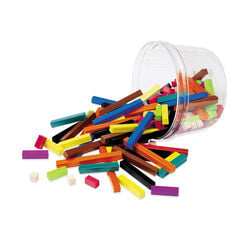Hi, my name is Dave Godfrey. I’m a teacher and an independent primary mathematics consultant from York, and I’m passionate about the use of concrete resources.
The focus of this blog and its accompanying video is on the use of number rods.
Number Rods
In recent years we’ve seen a renaissance in the use of Number Rods in primary mathematics. In this short video, I’ve explored some of the current uses of Number Rods, which are often referred to as Cuisenaire Rods after the Belgian schoolteacher Emile-Georges Cuisenaire (1891-1976) who invented them. He had the idea of creating a set of rods with all the rods of a given length having the same colour. The one piece being a 1-centimetre cube, with the two piece being the shape of 2 centimetre cubes etc. His original rods were wooden and stored in a cloth bag. Wooden rods are still available today, but most school are using either plastic or foam rods.
As with most mathematical manipulatives, Number Rods have their own unique properties and benefits. They are really good for some things (like Bar Modelling) and not so good at other things. In this video I’ve explored some of my favourite Number Rod ideas and utilised both the small rods and a set of big foam Number Rods sold by TTS.
Number Rods and Number Frames
For younger children, Number Frames (shapes) are easier for children to recognise as representing a number, because they can count the holes in each shape. One of the great advantages of Number Rods is that the 6 pieces can represent 6, but it could also represent any number you may wish! For example, it may represent 3. In which case the 1cm3 piece would represent 0.5. This also means they are ideal as a manipulative for use with bar modelling.
Number Rods, Measurement and Number Tracks
The fact that the 1 piece is 1cm3 means the rods can be used to measure objects and length. They also work really well within a Number Track. I’ve modelled in this video how you might use the Cuisenaire rods to represent the fact that 65 – 48 = 67 – 50, and I’ve also modelled the count on strategy you might use on a Number Line. Equally, I can model addition, multiplication and division problems too. For example, 33 ÷ 7 = 4r5 can easily be demonstrated by reasoning how many 7s can I fit into 33… I can fit four 7 rods plus one 5 rods. In fact, the combination of Number Rods (or maybe Base 10 longs and units) combined with a Number Track are the best (and maybe only?) concrete resource we have that can model strategies and structures within each operation using a linear Number Line.
Number Rods Visualisations
The original Cuisenaire Rods contain pieces for the numbers 1 to 10. The foam Number Rods from TTS contain additional rods for the number 11 and 12. I really like this development as it opens additional opportunities for reasoning. I can, therefore, model the factors of 12 using the foam Number Rods. With both sets there are a host of visualisations that can be used to stimulate thinking, develop and demonstrate understanding. These include number bonds, factor walls, fraction walls, number walls, algebraic sequences etc.
Number Rods and Bar Modelling
In the final section of the video, I model how you and your children might begin to use number rods whilst Bar Modelling. In the second example I’ve demonstrated how using the Number Rods as a physical resource enables children to capture the movement in a word problem. The example uses the following problem: ‘Tim had 5 times as many stickers as Anna. After Tim gave 10 of his stickers to Anna, they both had the same amount. How many stickers did they have between them?’ You’ll see what I mean when you check out that section!
Your use of Number Rods in school
Number Rods are powerful tools that fit perfectly with the CPA (Concrete, Pictorial and Abstract) approach within the teaching of mathematical mastery. This video may act as a bit of an introduction, but I’m sure there are a host of ideas that I haven’t covered.
How effective are you finding the use of Number Rods in your school? Please do share how you’re creatively using number rods with your children – I’d love to know!
With many thanks to Dave Godfrey for writing this blog for us.
Dave is an experienced primary teacher, mathematics consultant and trainer from York. He is also an author, songwriter and NCETM Professional Development Lead for the National Curriculum. Dave is passionate about equipping teachers to teach mathematics with deep understanding, clarity, enjoyment and creativity.
He is best known as the creator of the Number Fun. The Number Fun Portal gives access to over 350 videos that feature a unique combination of visualisation, animation, story, song and humour. (numberfunportal.com). Many of these videos, with their accompanying creative resources, include the representation of the concrete resources explored in these videos.
He travels widely across England to train and equip teachers, and to present his fun-filled and equipping Number Fun Days. Dave has many years’ experience of training teachers in the use of the CPA (Concrete, Pictorial and Abstract approach) and he would be delighted to support you and your colleagues in developing their use within school.
- numberfun.com
- youtube/c/numberfun
- dave@numberfun.com
- @NumberFunDave










